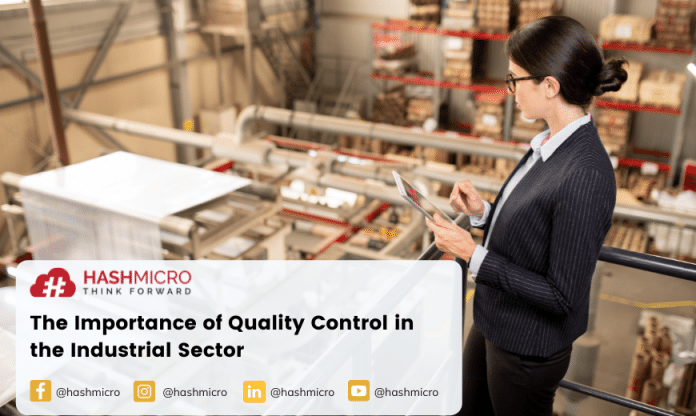The comprehensive inventory management system has become a part of technological advancement. If you work on the production part, of course, it is familiar with the term quality control (QC). What’s quality control? Quality control (QC) is an important process that any company or business must undertake, especially if the production is in the form of products or services.
Running a QC can be easier with the help of inventory management software. A fully integrated inventory management system enables businesses to monitor stock transfers and quality control. Not doing a thorough QC will cause errors that could later harm the business.
Many companies are implementing the best inventory software to automate the QC process. Therefore quality control has an important role, as all goods will go through the inspection process before delivery to know whether they meet the company’s standard or not.
Key Takeaways
|
Table of Content:
Table of Content
What is Quality Control?
Quality control or QC is very necessary for the industrial sector, ranging from manufacturing, and production activities to the results of production. Quality control is a process of checking and testing conducted by a business or a company. Measuring and ensuring that the quality of the product meets the standard.
This process can make an entity in quality assessment of various factors involved in production activities. Generally, those doing QC duty are training personnel who make product quality benchmarks and check visuals in the tests of products that can last before, during, and after production.
Even so, this process is the responsibility of all employees. These tests can be done manually or with the assistance of technology. Moreover, this process could make the quality of the product better before its release to the public.
One of the few experts Dr. K. Ishikawa claims that quality control is an activity to research, develop, design, satisfy consumer satisfaction, and provide good service.
This procedure is vital because it helps improve and control product quality before it is sold, and it helps a corporation reach its goals. The main purpose of QC is to ensure that products are sent to clients in good condition and meet quality standards. A quality control template can be a valuable tool in streamlining the QC process, helping businesses consistently track and maintain product quality at every stage of production.”
Also read: Production Process in Business: Definition, Types, and Characteristics
Difference between Quality Control and Quality Assurance
After learning what quality control is, then what is quality assurance and what is the difference? The fundamental difference between the two is that the QA checks into every system and the software needs to run properly.
Quality assurance also focuses more s on disability prevention. QC leads to software testing to increase product quality and meet requirements, thus the emphasis on spotting errors.
Quality assurance (QA) is a proactive process, unlike QC, which is a reactive process. From a different standpoint, if quality assurance has a cost-based approach, quality control is a by-product.
QA involves the process of handling quality issues, while QC verifies the quality of the product itself. Quality assurance is the quality of the audit and for example, the quality control in the inspection process and testing of a product.
The Quality Control Elements
Control
The first element is controlled in management which should be present at QC. Such control is like the management of a job, defined and well-managed processes, integrity and performance criteria, and a record identification.
Competition
In maintaining the quality of the product there must be competition such as qualification, experience, and skill.
Closeness
The purpose of this closeness is the existence of quality relationships such as staffing, HR management, integrity, trust, organizational culture, motivation, and team spirit.
How Quality Control Works

There must be some internal methods or procedures put in place when performing quality control. In general, the QC supervisor will ensure the product meets the company’s standards.
They will test, examine, research, and analyze a product’s quality according to company standards and consumer worthiness. Here’s how the quality control process works:
Set a standards
The first procedure is to define the standard. Need to consider what standards should be met before the product is at the release stage.
Does the examination have to be one at a time? Or can you check just a few percent of the production in one batch? Doing this is very important at the beginning, for it will determine the effectiveness of the production and preparation of a product or service.
Aligning the company’s vision and mission
Next is to align the vision and mission of the company with its employees. This is important when running quality control because the main goal is to maintain the quality of the product or service offered.
To achieve optimal results, management and employees must agree on maintaining product quality and standards. To align that vision and mission, the company can train its employees and set standards as in the previous points.
Improve the products offered
After determining the company’s standards (benchmarks) and aligning the vision of the mission of management and employees, the next step is to run the QC. In this quality control procedure, finding out how many products fail is one of the things you should do. Then, the responsible team can fix the product to fit the standards.
By doing QC, the percentage of products that fail can continue to decrease. So what if that hope is not achieved? What if too many products fail or services that don’t satisfy customers? If it is already at that point, the company must make a plan to improve the production process.
In essence, this process will continue to rotate, to ensure there are no errors or at least minimize errors using an quality control report.
Benefits of Quality Control
Not only about the quality of the product, but quality control also has other benefits that can support the sustainability of the company and survive the market competition. Among others, as follows:
1. Product consistency
For products that go through the QC process, of course, the consistency will be maintained, even starting from raw materials before production. This is the final quality of the product. When running quality control, you must have set the standard at the beginning.
As a result, every individual ensures that the product meets quality standards, — in other words, that there are no defects before the product or service is on the release stage.
2. Increase efficiency
The purpose of this efficiency is in terms of the production process, power, and time. Because, if you do not do a QC, there could be errors or defects in the product after release. Of course, you have to fix it, and it will take time, cost, and effort.
Therefore, it is better to check it from the beginning to avoid damage, so that costs, time, and energy can focus more on other things such as quality development or maybe business expansion.
Also read: Discover 10 Effective Business Expansion Strategies
3. Maintaining customer satisfaction
Implementing QC can reduce and avoid fatal undetected errors. Because if you ignore this process, it can make customers not want to buy products or use your services again.
Of course, there will be customer expectations when producing a product that is already in use. By building good standards that previously customer satisfaction will be maintained because it is one aspect that can affect customer loyalty.
Quality Control Responsibility
- Document inspections and tests on a company’s products or services.
- Monitor, analyze, and also test, and research all products.
- You can recommend reprocessing for any low-quality products to the company.
- Monitoring the process in the manufacture of products and monitoring their development.
- Verify the quality of the product.
- Ensuring all goods produced have a quality that meets the standards that the company has set.
Also read: Most Important ERP Modules and Their Benefit
Conclusion
That’s the complete explanation of quality control ranging from understanding, differences with quality assurance, elements, how it works, benefits, to responsibility.
So the conclusion is that QC is an important aspect of producing products or services, in order to ensure quality in accordance with company standards so that it can meet consumer expectations.
The difference between QC and QA lies in their focus. QA focuses on disability prevention, while QC focuses on identifying or finding defects.
In addition, there are also other elements in the QC that are also important for you to know such as control, competition, and proximity. Quality control is closely related to inventory control that can optimize storage in your business goods inventory.
Not only that reducing the risk of losses due to inventory recording errors can be resolved with the Inventory Management System from HashMicro which has been integrated with inventory features and can create inventory reports and track them automatically.
If you want to feel the greatness of many other features in facilitating the management of your business, we also provide cloud-based ERP Software with the most complete system and can adjust to your business needs. So, wait no more and try the free demo today!

{ “@context”: “https://schema.org”, “@type”: “FAQPage”, “mainEntity”: [{ “@type”: “Question”, “name”: “What is Quality Control?”, “acceptedAnswer”: { “@type”: “Answer”, “text”: “Quality control or QC is very necessary for the industrial sector, ranging from manufacturing, production activities to the results of production. Quality control is a process of checking and testing conducted by a business or a company. Measuring and ensuring that the quality of the product meets the standard.” } },{ “@type”: “Question”, “name”: “What are the benefits of quality control?”, “acceptedAnswer”: { “@type”: “Answer”, “text”: “1. Product consistency 2. Increase efficiency 3. Maintaining customer satisfaction” } }] }





































